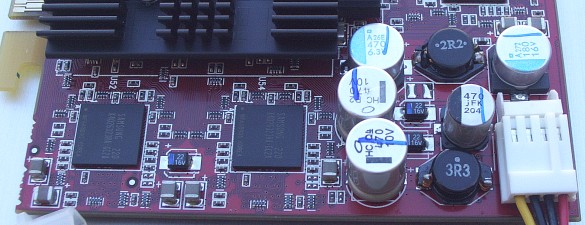Card I
Enough preamble about the current state of the high-end, consumer-level graphics card market, let's now have a look a visual look at ATi's new flagship.

Compared to the, say, busy-looking GeForce4 Ti 4600 PCB, the R9700 is a relatively muted affair. Even though we're working with a lot less PCB space, the board is simply laid out with the minimum of fuss. You wouldn't think, on first appearance, that this housed the fastest GPU on the market.
Weighing in at around 110 million transistors, the R9700's GPU is by far the most advanced yet, features around 65% more transistors than NVIDIA's GeForce4 Ti 4600. Considering that the R9700 is still built on the same 0.15-micron process that the Ti4600 is, and sports a core clock speed of 325MHz, fitting 110 million transistors in, and keeping it cool enough for operation is a fine technical achievement.
The added power requirement of feeding all these transistors manifests itself in the inclusion of a separate, on-board power header. Located at the top-right of the PCB, you simply connect up the supplied floppy-style connector to a PSU molex. This external power helps keep the load off the AGP slot.

The GPU cooler is a relatively low-key affair considering the task it is employed to do. One of my chief criticisms of some Ti 4600s was their overbearing fan noise. Thankfully, and surprisingly, the ATi stock cooler is pretty quiet. I run a quiet system, and the noise emitted by the cooler's fan is barely distinguishable from the general hum emitted by the system.

The back of the R9700 is pretty much what you would expect. Just be careful touching the card whilst in operation; as my finger will no doubt testify, it can get pretty damn hot.

Tiny BGA memory, first introduced on the NVIDIA GeForce4 Ti 4400 / 4600 cards, makes a reappearance on the R9700. Running at elevated memory speeds has forced card designers to adopt a different approach. Equipped with 128MB of on-board memory, in the form of 8 x 16MB Tiny BGA modules, the R9700 matches the Ti 4600 in this respect. On our test card, the memory was inherently 'clocked at 310MHz (620MHz DDR), a little shy of NVIDIA's Ti 4600's 650MHz DDR clock.
The overall memory bandwidth of the R9700 is a whopping 19.8GB/s, far in excess of the Ti 4600's 10.4GB/s. How is this possible with a slower on-board memory clock ?. Simple, the R9700, like Maxtrox's Parhelia, features a 256-bit memory bus, as opposed to the standard 128-bit found on the Ti 4600. The 4600's total bandwidth is derived from memory speed x 2-bits x 8, so 650 x 2 x8 = 10,400MB/s. The R9700 works on the same principle but doubles the bandwidth due to the double-sized bus. So, 620 x 2 x 8 x 2 = 19840 MB/s.









